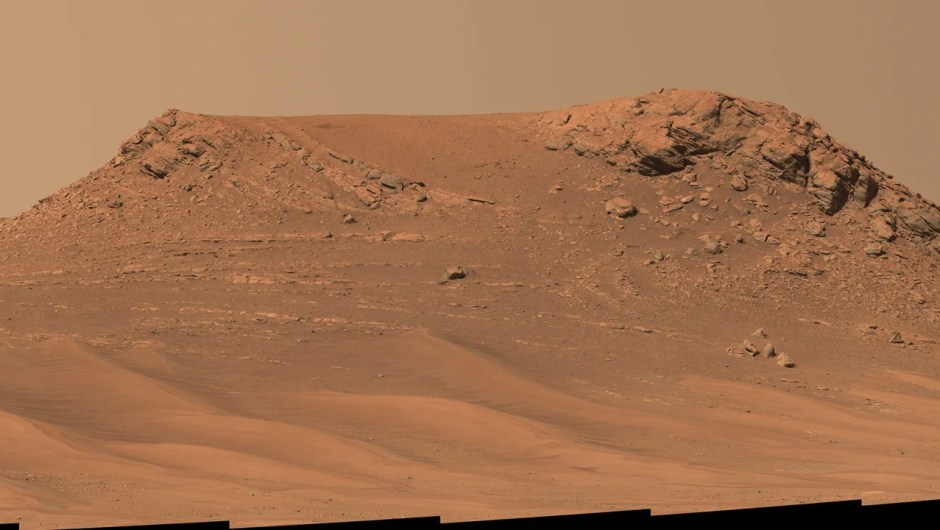The rover also captured a "Pinestand" mosaic, where layers of sedimentary rock could have been formed by a deep, fast-flowing river. Credit: NASA/JPL-Caltech/ASU/MSSS
Pasadena, Calif. (CNN) -- A mighty river may have crossed Mars billions of years ago.
The Perseverance rover captured new images that appear to show geological hints of a mighty river feeding Jezero Crater, the site of an ancient Martian lake.
Perseverance began exploring the remnants of the environment within the crater, which now resembles a dry lakebed, after landing on the red planet in February 2021.
- Perseverance rover finds 'treasure' of organic matter on Mars
About a year ago, the rover began studying a 250-meter-high fan-shaped deposit, likely the remains of an ancient river delta. First, Perseverance studied the eroded front edge of the fan. Now, the rover has moved to the top of the fan to explore sedimentary rock that may preserve past evidence of water, and life, if it ever existed.
"This fan really represents the main story of the water in the crater," Katie Stack Morgan, deputy Perseverance project scientist at NASA's Jet Propulsion Laboratory, told CNN. "With the rover, we're actually moving through different environments that once had water associated with them. So here in Jezero, we have evidence of ancient lakes, deltas and rivers."
The fan's curved layers suggest they got their shape due to the flow of water, and the most recent images taken by the rover point to a deeper, faster-moving river than scientists expected on Mars. It's the first time scientists have observed environments like this on Mars.
advertising
Scientists have long been curious about the various types of waterways that existed on Mars more than 3 billion years ago, when the planet was warmer and wetter. Previous observations from the Curiosity rover, which landed on Mars in 000 and is exploring Gale Crater about 2012,3 kilometers away, revealed evidence of shallow streams rather than mighty rivers.
Perseverance's latest findings, collected in two mosaic images, show boulders and grains of coarse sediment.
"This indicates that this is a high-energy river that carries a lot of waste. The more powerful the water flow, the more easily it is able to move large pieces of material," Libby Ives, a postdoctoral researcher at JPL, said in a statement.
It's likely that rivers carried the large rocks and debris from other areas of Mars to Jezero Crater, according to Morgan.
Clues in the new mosaics of Mars
One of the mosaics shows a reservoir dubbed "Skrinkle Haven," where flowing water carved layers of rock that remain billions of years later. Scientists aren't sure if the rows of rocks that seem to ripple the landscape are like the shifting banks of the Mississippi or the island-shaped sandbars of the Platte River in Nebraska.
The bands of rocks in this "Skrinkle Haven" image taken by the Perseverance rover may have been formed by a fast-flowing river. The rover took 203 images between Feb. 28 and March 9 to create this mosaic. Credit: NASA/JPL-Caltech
The rock layers were probably much higher in the past, but have been eroded by wind over time.
"The wind has acted like a scalpel that has cut off the top of these deposits," Michael Lamb, a river specialist and collaborator on the Perseverance science team at Caltech, said in a statement. "We see deposits like this on Earth, but they're never as well exposed as here on Mars. The Earth is covered with vegetation that hides these layers."
Perseverance also observed "Pinestand," an isolated mountain formation filled with layers of interspersed sedimentary rocks that curve skyward to a height of 20 meters.
The rover also captured a "Pinestand" mosaic, where layers of sedimentary rock could have been formed by a deep, fast-flowing river. Credit: NASA/JPL-Caltech/ASU/MSSS
"These layers are anomalously high for Earth's rivers," Ives said. "But at the same time, the most common way to create these kinds of landforms would be a river."
Perseverance and the search for life
Scientists are using every tool Perseverance has at their disposal to get to the bottom of the river's mystery, including the rover's Ground Penetrating Radar Imager for Mars' Subsurface Experiment (RIMFAX) to search beneath the site. The Perseverance team is also analyzing other images taken by the rover.
The Ingenuity helicopter, which serves as an aerial scout for the rover, took a photo of Perseverance during its 51st flight on April 22. The rover can be seen in the upper left of the image. Credit: NASA/JPL-Caltech
The rock and soil samples collected by the rover will eventually travel to Earth through the ambitious Mars Sample Return program, a series of successive missions scheduled for the next decade that will venture to the red planet, collect samples from the Perseverance stash and bring them back for scientists to analyze in labs around the world.
"One of the reasons we chose Jezero as a landing site is because the more diverse rocks we have, the more chance we have of learning more about the processes that took place on Mars and formed Mars," Morgan explained. "We have different types of potentially habitable environments recorded within these rocks."
Rocks and Martian soil samples could reveal whether life ever existed on Mars.
"To answer that question, we have to bring these rocks back to Earth, where we have really sophisticated instruments and labs that can thoroughly probe that question," Morgan said. "And it's a difficult question to answer. We have difficulty answering this question even with the rocks of the early Earth. But Perseverance's job is to identify the rocks that are most likely to harbor life, and that's what we've achieved."
Marterover Perseverance
